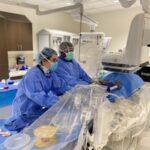.jpg) As we enter the 2011 Hurricane Season after five years of no storms hitting the coasts of Florida, there is a tendency to become complacent about our buildings’ emergency preparedness. The tsunami in Japan, tornadoes in the US Midwest and the highest levels of flooding along the Mississippi River in 60 years, represents the capability of nature; and our wake up call.
As we enter the 2011 Hurricane Season after five years of no storms hitting the coasts of Florida, there is a tendency to become complacent about our buildings’ emergency preparedness. The tsunami in Japan, tornadoes in the US Midwest and the highest levels of flooding along the Mississippi River in 60 years, represents the capability of nature; and our wake up call.
Emergency preparedness for medical institutions comes in two forms: the operational and the physical. Leaving the operational planning to the administrators, there is still much work to do to protect our medical facilities.
Our lessons learned from Hurricane Wilma and those storms before demonstrated deficiencies in window installation, significant water penetration, numerous unprotected openings, unprotected equipment, unprotected tank farms and chillers, and even walls incapable of protection from high velocity missile impact (HVMI).
Vulnerability in medical facilities included details and systems unfamiliar to some contractors. There were parapet flashings, roofing, and design and construction deficiencies when trying to exceed the minimum requirements of the code. Typical details from manufacturers’ manuals require embellishments and additional safety factors to be incorporated into the design. Hurricane design detailing becomes more "evidence based design" applied to the building envelope. It should also be understood that every building is different with different heights, sizes and shapes, and different materials of construction. Therefore, the same solution will not be consistent between one facility and another, nor will the construction details that protect it.
After Hurricane Wilma, many hospitals made great strides in protecting their facilities. Some buildings were hardened, energy plants upgraded and budgets prepared for the improvements to meet all the needs. Unfortunately, after several clean hurricane seasons and ever tightening budget constraints, many facilities have delayed or scrapped plans for additional hurricane hardening. Therefore, there are still medical facilities with partially hardened patient areas, exposed infrastructures, non impact, non shuttered windows and doors and non reinforced walls that remain vulnerable.
The work that commenced so diligently four years ago needs to proceed again with a renewed sense of urgency. The current weather events around the world are our wake up call.


























